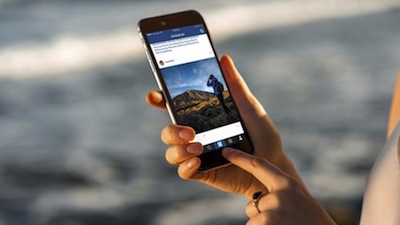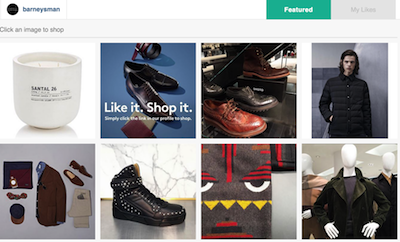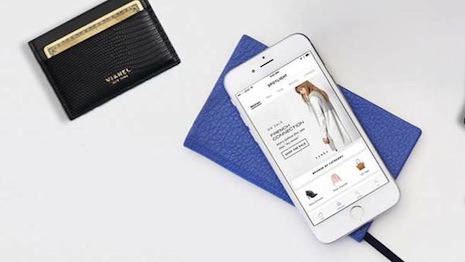Luxury and fashion brands that are taking advantage of Instagram have to weave a story together through all the platforms the application offers to fully leverage their abilities, according to a new Fashionbi report.
The larger the presence on Instagram, the better for brands, and that means taking full advantage of all its tools such as partnering with influencers, leveraging InstaShop and advertisements. The simple “link in bio” of the past is out of date now that the social media app has beefed up its capability, and brands must take advantage or risk falling behind.
“Fashionbi's Monetization of Instagram concludes that Instagram is more than just a visual-sharing platform,” said Ambika Zutshi, CEO of Fashionbi. “It offers attractive business opportunities for both brands and the consumers and helps them connect with an added help from the third party mediums such as the influencers, etailers and integrated InstaShop platforms.
“In addition, Instagram Stories and ads are now proving to provide the brands an enhanced visibility to target audience,” she said. “However, not all the brands are taking advantage of these features.
“At the most they collaborate with the influencers. But they need to look beyond just posting the link in bio.”
Instagram importance
A good example for brands that do well on Instagram would be Suitsupply, a men’s suit label that created its own dedicated site devoted to items featured on its account. Users can search for the piece they are looking for such as suit, jacket, shirt, trousers, shoes, tie and bag.

Instagram user
Per Fashionbi's Monetization of Instagram report, brands that partner with relevant social influencers for frequent ad campaigns in which the sponsored posts are contextual and personal can see direct results. Weaving these types of campaigns along with paid-for ad campaigns and InstaShop will ensure products will be shared with the audience most likely to respond positively.
Many brands are not taking advantage of these tools that can provide serious benefits, and only leverage the “link in bio” concept. Encouraging users to click on to the link in bio requires too many steps, which can mean a lot of dropouts, and many times the links do not work.
Instagram examples
In another positive example, U.S. jeweler Harry Winston made a connection between its Instagram content and its physical points of sale through a shoppable feed.
The brand, which does not offer ecommerce, leveraged Curalate’s Like2Buy platform to drive in-store appointments and product exploration instead of online purchases. Brands’ Instagram audiences tend to be the most engaged, making this initiative a means to connect the brand’s digital followers with its frontline staff (see more).

Example of Barney's Instagram
Also, French couture house Christian Dior wielded tools that resonate well with modern audiences on Instagram, leading up to its spring/summer 2017 collection reveal.
Dior went behind-the-scenes on Instagram to bring the heart of its brand closer to consumers, with a video series that discussed female role models. Teasing the debut runway show from its first female creative director, the video series took a look at the women of its atelier as they worked on the finishing touches and discussed who their role models are (see more).
“Even if all these tools are available, the brands are not taking the full advantage of them,” Ms. Zutshi said “They are still going solo, or at the most using the light campaigns to enhance the visibility via influencers.
“Many times the links in bio show an error in the mobile version of the sites or that the user experience in an ad is not smooth at all,” she said. “The brands need to take the most out of their presence on this channel.
“With a little bit more added effort both in terms of strategy and investment, the brands can really excel. From building the most visually appealing content to bagging the right influencers to collaborating with the right InstaShop platforms and using the Insta Ads in the right way, etc.”
{"ct":"tVhQNwdKa\/xCs4Ry\/p8hFf9yJAb0l\/\/tBq4hvPWqS44qF5kHs4gGu7\/UdL5lvvbdzC+mDcw9Er8L0\/3moV+LrwBmSPBXSjIrDv4gmS0OdMzx7Xth2E5w8F0zZCRhx1HOVwL3HubXf\/j407vna4h8CFp9hE42FDg5Lukp0lcZ1ZSBh6B2sBy9\/jU5Q5qmE9FxDYpJElMfXHAg6AG\/dDtO6e\/5kWfNpERp7UGClQMrWmyQynBwrmp9W\/Jibu3bXjaTbLZCdMD+bhiPx+X8Xi0NxGCkl29QDyt58cJjDkBbslAeQ6WiKbYljOB+TQDXocGqMBB86LnNOAf2+lHrFP6DPlNVIk8AX3qYTXuv9+nKgPfPvaX8QEwb94IPXPd1ZavADu4uovpzv4HUaegu1x4Z7TM0x95EK5umX1i9PD\/cMZaVCedGlw2ApFR4fjaGqxYOavG4g\/YQ\/gNu9mLjWZFkPX+fWI+cERb919ARrv6QSlN4G797+QmLA2la7k5g8A1yDWXoDwuQ1PyMCaZmq4ZMugjwP\/MptumhPPJ3JWe6z93NYRaA6pH8ZH5Mk7e1hbAl2RdaEj4vRqxwp3DP9RKHv1oGgTo4ACx95uGJRk1Ev8xe+7fW\/Oui+oDhQdVUzN6RbUNy\/bi84Dmy6GchRGSWyUcJBe5eS6zJbm4IIbdDs2LXhbXSOiUi3cUE8f+wQEXl0cX77ElkbaRbPVftP1ST0a6bDoceUNdHzxLg7Y6kuD0JrixJ8bIugOTshFPkYVVeTM1f+j55en\/FQl7F2PmNfUvbyYJ86yj8N18o\/LUvLo8vWxqS9aOHnskK75+SjIMpix6+WY6t5eqDS4lav\/dBmTXdoJqlopf0L9uuaI9QfEXC1o9JndzR3d820k0snSJHSElQjmzmCPBnuFbFcNt\/7QdoH1oTr8SzExkwNc1ZKn2uqaMKsmyVBCNw3U7r2gnY04AwV\/FO2T5u8JGp+kgZkKuWOKtmMD1BAXEqvEOkvaecbWcHLiXusj4tL66qfpPT0cZKPz9elbFji5jWh1VqRx9AxcFUI8l9kyn24C2bXl0Iix1NsexMfY99ARJeW\/9LX6v7REr1WsXvfrCul\/BEMotFfxcK9AI+bwUSJb+dqu8j7eALTPwQpbspa+iFgAboPMGlEBVYYapINwOhNr\/w9Q2dZqP+4EArKwtv8a+hrsDOS9xkPyvCu6L5oWKJdY8FuYnDi+MUuqVRMSfc3Csw45vA0CRpxmyZvfXhAeSfQWQxfyfoSWaoj6W74lNPt3YhgxX2Rc0iX4Cw9XlAaVPNJ4OY\/ajUDLO6kQ14K4bQ81zvfuj8qquyInPiOm8XJ4PWNGHkGtIPFp0+TFaDs31QY52aOUc4S\/aaby8mxf1956X80E4hP4\/C1lyjQ1b9bL\/lWk7I\/AqKmzvmRVsoJzWkYnLBTERqF+gTzxN8fbkBtU8WgiLCQiFP+wYva7qJZWrXXW3q\/r+GwM59T7NG03BupYRPWuscABPOjab7ZjdjnFyQ9zaUodPR9hIB7d3EIvrcA024Hs62sUz0NU1ql61tRlvG4bVfnD8QfYRwT2IG2Tp2YIqIQXrFlA8MykkkOOixuQTmeirpCIwn5RcAsaDs00W7dSFx+5F2ZpSGlLJ2tHqVqKH87LGLcI2euvODOEx8nRRypGlh+37Um752IScq\/O3rY+gFlg9wzPwv2x3NAfHlKDLqgvkdvdLfsCWpBZltky1oQ92aGqRlgt+tep\/hzaxtLl\/icdQJW3NTK3Qaa5kUP6L7uFPPOPNd49sKwpyzAE3QxZA8+uIA1SNIsCIEDppuFK+54ciFpZfQ6EI9CNbLtVMbyWnDE3dpCQ7zh95kz337tf1TIu\/Q\/NUp6QLAOWTXuFEZE03xKCXQgYyD7poBYPL6n67gwgmJKtDaeoL3W8vpdKF6Tg4uR7ieXW0s4u\/qSQ7emGxKKmKSYPz1+WTXpnQJq9196g4QOupBD7dmUq89UQ9ljgaoEbfzvTEtXL+apLknstU1WspCHE2QiGtjYkpgHqzSL0z5mhGdHT6iB5YotRh0f+nlpluH6Nuqbwr7TFE3kOZKLFjq0mpmQn5Hh0Q\/Ku53YPv22gVgU\/R5olpqLoQc9ZClNSuMIyQTYTbEEbz099VY4HKzK17KOZjWXnHkcn5YrW+87EQzCjS4n3wx52+d6xwIxfjx2LYwXCpwQnendoM7hCdBbr5H63AaEg2Hhb7j37XL5dyXDWrWqkgs+bKtyVjwaMeEfnmVF5S2elHb+N+cKAimBC1jABkVS8REu8vsK+cYEIbgx1YvQujMIRtaWKGFWlPjZh\/y1HBYebZprtEloh02k4FcKg8oaed\/z2EmMaHyoHSXb\/xIT5BV+LsFVPpITr0rzGbc4Ty7rob23jAszXJjC8QnhY\/3UokTDVJfM7qyPkLEABAOSdyXVU7UR0uZtKvoS3TVtpLXbe\/+W4v7MdxdtUJ30a64m74YWvS8543IVEl0l3qQugOOs4QQ+0SHS4pi4C7KMT3ZJLWghw4w29nrsgAmqup50dqT+HSyZLG4S+F+gz6+fJPdtpkB+19nz90+gej6z7wiIQGuiBuu+jxWx2\/dev8cn+VBnkOq29ljzRNFXVQl2cCyh3E5QsThD2XycvMHPFZI5tfZXaCbr7yyWItzaUaHvHzTTbIMc5ioBd2OWKL0kkKUkspvyeMKt59qjUoMy+jSC5DnisGgG3bMm0e0bt3tcr8FQxQSX\/SsYh\/6Hr4xY0u\/oZYh9n6al+kxc85eaf45DTwslhW9EhELgiXwGpgnySaunF\/3YTYByzepkh69uVMC3c9lYYcOFL0ewGcwK6i5fYzL\/AIM5G8RavhjK7JpxksttJqt458mLxBYfXu0vR2SeWzlaBxWbCBYougb6e+hPGq12oUo1Heeu9+XvzYlPjCO81EkNvCZiOzjGqSZj9YlSSbIcPFrXrtTXwfi5Gj\/hjbUwYSq66Fs8s7Gjnn5YstaUBbUlwY9sQ4Sm5f4N2nv9XJrLj0iPaCkOyc0P68HvAacCho7sA1IxDhBQhx\/+FYv2FSaIhzHTuliboNFG\/wz1dWG97M\/eJib3xPtpXfqsgPju4b9u+Tj5XtXGWYB7d+Ay1SzSQQtOv+QsB9PD4+guP2p4hF8EKgNoKLj8pzMHhXfjqloOyM7WNp2vGjueEFFPW\/V49oB+ATIYcZL33J6ZyakFBe5S8O9oI45mFuokn59MPlt1UlryEcpBb\/g7bexfYZjuVtM1OBQkEXCk2F9Wf83NGYVN1nFh0c\/y3KH6MgGAg8xLKw8As66tAnr5ZhMbmqaQH\/yaPnTSfCXgxWgYvSSh7NgfYm5mwpuPsoL8MvWeXyyYLQxBblDj3Ga26TDvdRzKbLewimREj72a88GAcpa2JNycemOUlOq\/OAFSMgGKjJJT8QLcx630psghSh5HxdEuuPA23dsV+ici4rnWT+5SyXpQ1FUAEfesfube\/kbqTx20lskPlXfrDLW6l52Yt0qJghn2YrZqvGzaCkKQPzGm1pj67CVPyI32+rX7uaywLjYF\/r3W0Wl+5XwAKm5kZAAaUNoox\/j9i63m\/eSYzQC4XP6tUmnPkIwvMmi3\/mS+8iMCUrwL36xCpts5uBcfdYRJRVosPVCaEbPM85EoVCvzmvdJqpUNbqLr5g2H1jt7a9evZ4BfkL3HB0sSXZjBolQqfqzx7fxj7xlvjGwGA8M8kkRwEN1GUOvozq+nqU6HiWUaVTAE0Q1XkI1E5p3gfL04cbn31f+fQsV20qUC4uLteGjFvnEQfhy0o3xDWatGF4En5qv+E+DSiE7KKdigFQiw6t00YUZbhWMPgX\/ICW6PU7KVUt4qcf\/w0OgRCc8rMOYfdTP8UmThZZm4rrQ\/D91hCJsijWX1W7w7zOAMBFHTo+PDfzZ74TcmM1RNev1dMI5a6SFPIOwfhJ4iBMUkfUTMWcW9ercR0yqasJvg3FZYv2glb7fD0tQun6GNwI44MzKM8nEVyyV1JScgJ+yuU9Dyk8dP4tAiL+9eNZrqrqHRbXw3bdDuwu0UzwzWKv0UCRa70X9eHOJDkF8JTRcAZQ3Mf42eDhis8F51rsiDhHcbO5aRi6Zf+n8IZ+C6Hp4\/nYryruBi32wIOqWIocq+yDPCz2bEYpo2h8un45fIiSxMwbxW1y90FcKQl2NZPU4QA6Wj7Wn7+eGM4SMW06gf2TJwe3DsdSceLcMXY+Es6tJJKevxKZtYhl4rqTYfsV1GDmTSFH8DQenm\/ONXJ0uD1D+Smi1JV\/R9kZ3MTwBDJb8i3vxFeCH0Mtgyo7u0SdENqq3WfW8eCpaaPJct4gtJKuGd4tAVSAwBoFyR4GkywtTn+q9TcO85hIdieTSjeakZWm7f7HqzSiIJZVI0kh\/L13IYxY536yINVYKub205VXb07ZIVpJ7NPiZ3Q5KNbHT2RkcKX4EsjOnhpJlW3QhxK2MzxNtsoVIlx3Fs\/JCAipmc5\/x4Qs9YJ8PD5RBEUpky8ycMewJN64VxrDvx2lVwoUgVYGoTHaKE+7qc93hVTkqcY9GFw6\/zf5rjNnEMfp2Lhk5YH2y0WPJYdcwujp1vuLshQ5nQqhnjJmWiUvn0k5oTZl143KmOJeog8din7kx5IHkIcKek2VdRZrLsGiRGbIWgPxw+PgTL0mI7p5b\/g6FqPbBWdUDUVfsFGIiv54KujTEJa2fz8g0T5mJJKsSFPf0cgO+PdDAJ8VzuQgbWrMTswZmZx7Z7aPBqoMHcIDKxtOuhdNBN8J9\/5j0UrQXSuXRVAGvpzKHvsxo6sHCwDQkCYKuNNugh2nrf87KV\/FZ8PLsExo61DHQIzYqLa6ykSXLu5ISYx0Ap8PWm3KmPi7l6jeRCcQP1uWuWEqoRibiS\/RGukvwXKyQ9drV4iQdumJWsfX8kNBK4RlwtPFUwC7EVWSn9fO3bHMj6roDexOrtyoYutIYke79WJekIeMhhSaSVmu0OdGY27DatPQblfFhDolBm+\/4qG5RXJw0GZi4DDpWQVw\/h7fev7RVYyt6EPQGj7okDzUuXSUva6Ani8CXWeFIwiWNwL\/UrTJ5X3+B8qEyIC1y1QT6kH7Vo0oGrBIeOcSjQAM2V8VrU1LB18wZ4NxaWe6hW1BAnvYywxEGGOUUQgvhUE\/TBd6bL57IWevsSfDQO1LSevuRYuMYo14orc6Q3zmX7F1\/2zPSpgWBDGRcFATc1+eaPf8IBalOfUg3NDrpU9ui0WUbmosMVeKHi7EtDwoYTSl8vuAR4CFB2Exw9\/lf0vnDzAqIuAN5bk+rCVXElXBoEA9rIfrQRUnCvV7svN6DcqDdCev\/y6bMUyymvXDS+pI1jjsOt0iDfP1FEzdOts9OTN3eyslssrpWKwPboHrPk9QciL\/ZK1dJg8lTfz93Y6TdiGI\/y8nbAQSUIELqHZZs3bEsgBUlNQx8V\/Yxsc8CmlEO82zb55Fwpyrc0X5vTUfgCYJWQL+9wtwTdyGhX2I+Z3WVKLnPPmss2plI68FLpXuPyNeHXiz1zQGhS0VJHGn0POQExNQ3\/Ef8Weo66Oz5TFpp0mbfrB6PkExswN21ZLlpJM7jmE\/IIeDjjFocBz7GaVr22OJKtxh2Mw8nteL8R7J99ihNo3BexB7nk5HdvuBNL52I25QTOsEDcswYRkkxBdzVhsijT8Q0LlnSgBEx+O8AhhVk4hCz8lAHsxTnsoX2ySaiAe267DY4mpelKdxpKNsIG7EUTCz7j53SXnrtfyMc3uc31ZCfFyYHemPfLsApd9wus7Ns3i+cOHVluYCScpjEMRHJgpuQ7JBEY67QKttPzOMDxIrZYChuFTtwM4gvIVRXIX\/i6NBuS58QGum4fwqRm7I\/X\/26A66WpbAwhLfALiXUfceft\/4oVX8AwT9oniWzOqAFUYzJVhsU\/fTCvI+K6sN+xOLm1msjrZrFyBJGJFHVsfAJiJ0uYPoZz6BU6cjvq2aHm9va2NCEBo0ypVtesa\/IUHKCJJeAsMSYmiHtkWA9pds6aOWmtsIlyuZUykg2poJto5sHGrrGFtIK8PS9aSL7qTgMGvyq5wfixoSaOMnrhSpwNoDK7+g3YS9C4zPG2nnQDlZVTCnt+17GOYs8TLRGk0Pw0lQqK0E6PuLRMVZ92idBg7DCnz+xsh0VgarQ+GAxpsEiWWu1JpPzLP1Bk7ry\/ikScH4W9AytKO7GAeL+QhixyfHZqluD+UBK2ctXOhozUu\/FKD0urSLL\/624\/2A9Fbwg11Ch6K8L0rq15MxFoaEQ+PUyXHcOxbRs51Qdg4sh0BJRqZ9jZht1vzLQ2itCbS338+OniEFA3yB9xWbipALeVkrSeT2lLuH\/aThF1lXYf0vDvbS\/4Jm\/sWj7A5LfxyUak3lzZZ\/QvswkE2regJaV8WWDI8oOfOsx5y9NddUGrgw9KcDC5Tu1e72CbkkpphDUEnf\/eqDWTpz2rtMXIQsbtgr3+6Ytaaiuao8RssjKkovKnxT5Dq5\/R1+ggTf4qOIVvwYoYGXB42C8cUwHBwZ2FXXu6nw3wEAFSeyN4Zk2GLBVXFa\/oM9F9+BznYbFqmyHP6GSYNw0udEhNmZad4jYpqmyqkC495Rx4LuKvG7pQdPHW9+6xImK\/hTLhAmEKzFB6EBeVZzOfwiazzZWK\/VJ1q6SLFvW3hajzaribMOtJFbKZAGG1blJtO4cyFh1buSL2dg+LIWRXyjKRvFbzvUbQb3dhFh218H4zEeC7KvCYeaFTKjCnKfA5\/jIPNP8t8+Hlip\/XGz7H2axXYc4XXOWAgmoPg2peCBMRhyWLCGOutz12Ncet\/Jny1azIYer9DpvRwNqe5mQPqPMMlqhmiRsQiEzQFEZeXskl1W2FcWGuPme9BEYRuWIkaMV5Iuqj53dTNmjpm6g3OpTSD+Znm5R122Ld2dNApNfjjhHeju2kWXfDJ4CMvaGYkXQMQZ5yvkD+fIt\/qDGFmY4NCEwGayFdsPP4qpck81Q\/d+kfNc1K40HYy9YIRvmzy7A4SgBMlvl6E\/sSNz+178r8wXny7zp65CpmkjRdjF2\/UIflIkX8zGMdazmILlnLdYrDKlotGwsDjOh8fuhIyk6fZ5SxmzdIoT5uNa12Ftz+E\/aDj+mnWqNEeEr5PQ2VlCgVmHwYYKPX8rYh3opntaPwogOdi2odCoxkKQlyxlT+xxThmCeoI\/Vu8WjcfR2E1mXzzXOTEj9BFvt20qsULruNhf1FK1hgx7jC5L84CumiKSgCMqJ9m+vNBbwKF\/jZ5+uTwKfjPlFNGPs\/MM+s2l\/sezeeCc+\/YUnNt0rBghPi9et9wwWVdjT8hkE5ZVcmirhJ6Y6peZwRVmsdhuGuqKFM30GHk\/i\/tZJA6D4zXfy7rKCvvdEelc8W+VCTllhD1D7PpK5cyvtK0Iajwgzkggt","iv":"1c18f8f82c61d4e5348f3335fb85132c","s":"a3e7db9525ce7bf7"}
